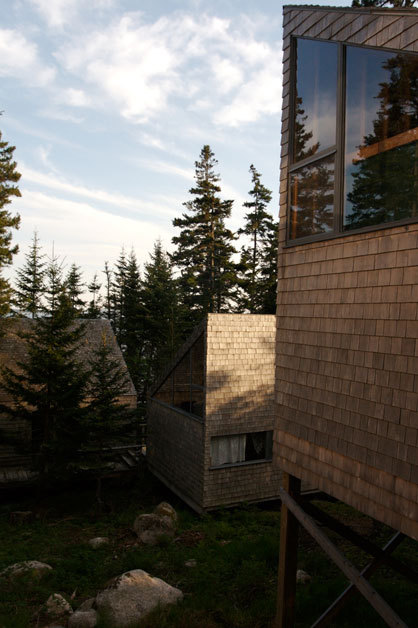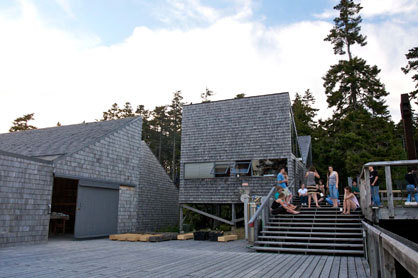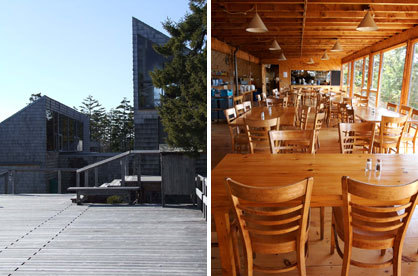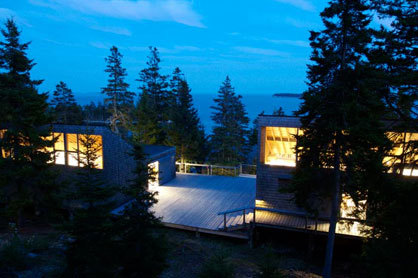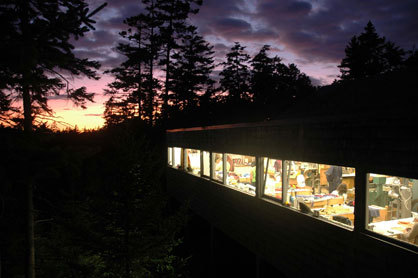Maine Journal: Needles in Haystack
Texto por David Sokol
Washington, DC, Estados Unidos
03.12.08
Stuart Kestenbaum is director of Haystack Mountain School of Crafts
Driving along Maine’s intestinal coastline, words and phrases like “bottom line” and “hardscrabble” appear in street and farm names. Appropriate: The local climate can be challenging, and its craggy land able to drive an Anne Proulx character to madness.
Toward the very edge of shore, though, conditions taper into softness. Moss wipes rocks clean of their edges, peninsulas and islands appear as mere wisps over water, and the fog of harbors and bays stifles rippling water and crying gulls.
It’s a fitting setting for the Edward Larrabee Barnes–designed Haystack Mountain School of Crafts. This much-honored campus seems to tumble down its precipitous site into the water. Equally notable is the way residential and workshop buildings represent a kind of softened modernism, with hard geometries and raked rooflines clad in indigenous cedar shingles weathered to a silvery gray.
The atmosphere may soothe, but not necessarily the destination. Since its founding in 1951, craftspeople, artists, and designers have flocked to Haystack for its short but intensive summer workshops. (The school moved to the Barnes campus in 1961.) Studios never close, techniques are learned, concepts ruminated over, and epiphanies had. While Haystack already plays a leading role among America’s artisans, its star promises to brighten as that community and the design world meld—think handwork and limited production runs, for instance. It’s a positive collision that Haystack itself has examined and championed in a series of conferences first launched in 2002; tellingly, MIT Media Lab partnered with the school for the inaugural symposium. I caught up with Haystack’s 20-year-long director Stuart Kestenbaum to discuss the magic of isolation, the realignment of disciplines, and the meanings of America.
Haystack encourages a loose border between craft and design.
Stuart Kestenbaum: Each year we bring some architecture students here. It’s a way of giving them an inside look at a classic building, and also have them work with materials in a way that architects don’t normally get to.
Would you agree that designers are seeking out these experiences more frequently?
SK: There’s a lot of crossover now. Fiber really blends technique and concept, while working with glass is pretty specific to the material. You can get tired trying to make distinctions all the time.
These are some of the issues that come to light in your annual conference.
SK: With the Cooper-Hewitt we looked at the hand in the design, last year we did a conference exploring the significance of objects in our culture, and this year the subject was the language of craft—consider the Museum of Arts and Design changing its name—and the difference words make in how people perceive what they do. Attending any of them, I feel like there’s a continuum of making and creativity and technology and making. Work in the studios here travels along that continuum.
What kinds of objectives do students and faculty bring to Haystack?
SK: Some people come with an expectation to learn a skill. Others are working on ideas. Often what happens isn’t what people expect will happen. Our biggest strength is giving people so much time to work. You can make a kind of leap that you couldn’t by working two hours a day.
It’s the last day of this session. What’s the attitude among the students—a sense of accomplishment? Shear exhaustion?
SK: They’re too energized to know they’re exhausted. Really, it varies. Each student and discipline has a different rhythm. In the second week students realize there’s less time than they had anticipated, so there’s an enthusiasm that continually builds.
Life-changing realizations take place here, I’m sure.
SK: There are moments. Take Michael Good, who’s teaching metals right now. He learned anticlastic raising here, when he was a young man, and his whole career is based on that contact. I think sometimes people may have something happen here and not have it play out for awhile.
What’s the benefit of this isolated location? Craft and art studios dot the roads leading here, so clearly Haystack has left a wake.
SK: Certain people come and stay in the area because of the school. So we’ve had an impact that way. But in terms of the isolation of the studio experience, once you drive up the driveway you’re here. You don’t have to think about where your food comes from or your home chores. That’s where the studio experience is essential. And you’re working with people who are feeling the same way. It’s less isolation than there being fewer distractions, because you’re in a community. You’re not like Thoreau, you’re with people who are pushing and experimenting.
The other thing is we have graduate students, undergraduates, cabinetmakers, all together. It’s not like being in grad school where everybody has the same language.
What’s American about Haystack?
SK: About a year ago we had a papermaker from Japan, Kyoko Ibe, as a visiting artist. During orientation I mentioned that we had a tradition of open-ended exploration. And she was really taken with that. She said, In Japan, you don’t even think of that as a tradition. A tradition is unmoving, and Haystack’s is a tradition of remaking yourself. It’s very American to explore a new way.
That identity is fluid.
SK: Yeah. If you think of glassware, there are Italian techniques that were perfected over centuries, but they don’t necessarily break new ground. Americans don’t know what the traditions are and try new things. If you put together the technique and the idea, you end up with a new medium. That’s typical of America’s artist-retreat programs: You need to be away from who you are to become who you are.
What do you make of a criticism that American design doesn’t figure largely on the world stage?
SK: You can’t say that America doesn’t have an endemic design language or community, because you can’t not design things. Look at the nearby town Ellsworth. There’s the charming village and the big-box retail on its edge. It’s another kind of continuum. At its best design is mindful of the environment and understands the tradition it’s working in. But I guess when you say design there’s an implied hierarchy. Who is to say what’s good design?
What can American designers learn from American craft? Is there a care and sensitivity to be gleaned here?
SK: There could be. There’s also an attention to detail and humility in working with material. You’re not just imposing your will on a material but you’re listening to it. Louis Kahn said to ask brick whether or not it wants to be an arch, and people who work with material really understand that. Yet somebody outside also could ask, What if we use the material this way? That’s where tradition and innovation come together. Which I think can happen at a place like this.
My interview with Kestenbaum ended here, but before I left for the day, he shared one more thought: that, somehow, American craft wasn’t American at all. Its insistence on material knowledge and achieving quality at an intimate scale, rather than the typical superlatives—biggest, fastest, cheapest—makes it “anti-American.” Let’s hope it’s a recurring benchmark.
Welcome to Unsung America. Inspired by Alice Rawsthorn’s critique that the U.S. lacks powerhouse furniture designers, this column observes the local communities and conditions supporting a variety of design disciplines. The “Maine Journal” entries are the first in a state-by-state exploration. Next time: A noted crafts studio undergoes generational change.
